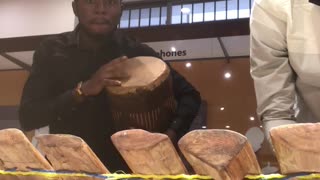Premium Only Content

Vietnamese traditional toy: To He
Vietnamese traditional toy: To He
These simple toys still give children immense joy during the Mid-Autumn season.
The recipe for success in making it lies in the preparation of the dough. The craftsman first grinds rice into fine powder, then pours water into the powder and mixes it until he achieves a sticky lump. He places the lump in a pot of water, brings the water to a boil, and cooks the paste for an hour. When the lump rises to the water’s surface, dips, and rises again, the craftsman removes it from the pot. Then he applies seven colours: white. black, green, yellow, violet, pink, and red. Miraculously, the different colours never stain one another when he assembles the parts of a to lie figurine.
Many generations of Vietnamese children have been overjoyed when their mothers return from market with a To he. Children can even eat to he after playing with them. Each craftsman embarking on the to he trade learns to humour customers, especially children. The lesson of humanity is the first bears in mind. “If we love people, they will surely come to us,” to he makers say.
Making To he doesn’t bring much profit. The materials rice paste, bamboo-stick holders, colourings – are inexpensive and locally available. A craftsman only charges customers for his patience and care. A To he in a rural market costs between VND 500 and VND 1.000 (US$.03 -$.07). Makers who travel farther field to the larger cities can sell a To he for between VND 2.000 to VND 3.000 (US$.13 – $.20).
Customers can place their orders, watch the craftsman mould the toy, and be pleased with the results in minutes. A To he can depict a person, a famous general, a folk-tale character, an animal, or a flower. The makers remember the characteristics of every subject. They are experts in using exactly the right amount of paste to form each separate part of each kind of toy as if these skills were an inborn talent.
-
 0:07
0:07
MRDUONG
4 years agothe excavator is working
294 -
 0:29
0:29
Kiabs
3 years agotraditional instrument
50 -
 1:05:47
1:05:47
Donald Trump Jr.
8 hours agoMexico Sends Troops to Border, Plus USAid Scam Exposed, Live with Brooke Goldstein & Rep Brian Mast | TRIGGERED Ep.213
170K131 -
 9:26
9:26
Rethinking the Dollar
4 hours agoUnbelievable Government Waste: 5 Outrageous Biden-Era Spending Sprees
128 -
 LIVE
LIVE
Flyover Conservatives
21 hours agoDR. KIRK ELLIOTT | Deep Dive: Tariffs, Tech, and Total Economic Warfare – Who Wins and Who Loses? | In Studio - FOC Show
1,071 watching -
 LIVE
LIVE
Danny Polishchuk
5 hours agoTariffs and Trade Wars + Nick Rochefort | Low Value Mail #136
359 watching -
 LIVE
LIVE
I_Came_With_Fire_Podcast
7 hours agoCartels vs The United States, Fentanyls 2 Front WAR, and FTOs
144 watching -
 4:54
4:54
CryptoWrld
8 hours agoCrypto Startup Launches Tokenized US Treasury Bonds
393 -
 LIVE
LIVE
We Like Shooting
14 hours agoWe Like Shooting 596 (Gun Podcast)
168 watching -
 54:43
54:43
Kimberly Guilfoyle
7 hours agoThe Trump Effect: Mexico Folds, Live with Dinesh D’Souza & Chuck DeVore | Ep.193
78.5K31